Introduction
The branch of geology concerned with the description, correlation, and interpretation of stratified sediments and stratified rocks on and in the Earth. The greatest part of the uppermost zone of the earth’s bedrock is sedimentary rock, stratigraphy is an important branch of Earth science.
Of the rocks exposed on earth’s surface almost 70% consist of sedimentary rocks.
Stratigraphy
(Strata= a set of sedimentary beds, graphy= description) reveals various details of the history of the earth during the different periods of geological past, from the beginning till the present. Through stratigraphy, we can know the past details of climate, geography, glaciations, orogeny, eperogeny, evolution, and migration of plants and animals.
Thus, as this branch of geology reveals the history of our planet, it is called as “Historical Geology”
Correlation:
Matching up exposures of rock that are the same age but are in different places is called correlation. By correlating rocks worldwide, geologists developed the geologic time scale and obtained a fuller perspective on Earth’s history.
Correlation methods may involve the use of:
fossils (*biostratigraphy) Rock units (*lithostratigraphy): physical properties of strata and their organization into units based on lithologic character.
geologic time units or intervals (*chronostratigraphy): Deals with the ages of strata and their time relations. Modern Offshoots of Stratigraphy
- Sequence stratigraphy.
- seismic stratigraphy,
- Magnetostratigraphy
- chemostratigraphy
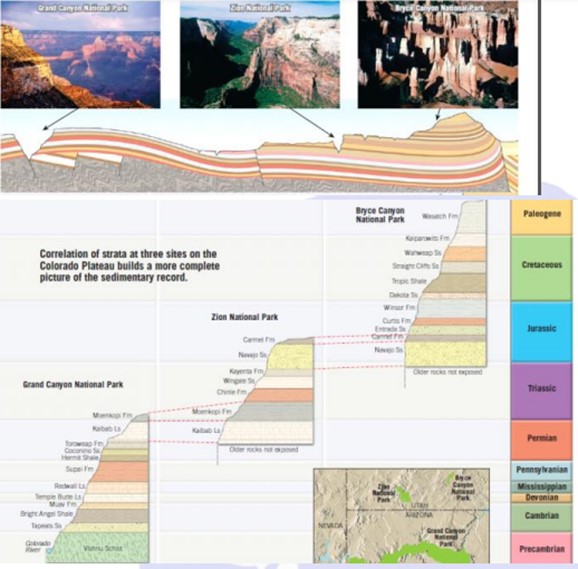
Note: No single locale exhibits the entire sequence, but correlation reveals a more complete picture of the sedimentary rock record.
Index fossils are particularly useful in correlation because they are widespread and associated with a relatively narrow period. Index fossils represent widespread and abundant species but have a short life span.
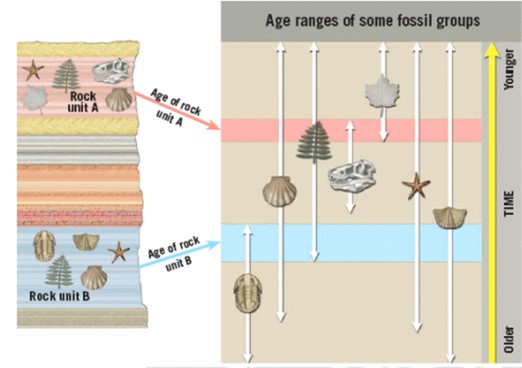
Facies: Sum total of features that reflect the specific environmental conditions under which a given rock was formed or deposited. Or bodies of sediment with distinctive characteristics are called facies. The features may be lithologic, sedimentological, or faunal. In a sedimentary facies, *mineral composition *sedimentary structure, and bedding characteristics are all diagnostic of a specific rock or lithofacies.
Principles of Stratigraphy
Uniformitarianism(J. Hutton):
The principle of uniformitarianism states that physical processes we observe operating today also operated in the past, at roughly comparable rates. Study of the present is the key to the study of the past.

Law of Superposition:
younger rocks overlie on older rocks. Steno proposes it
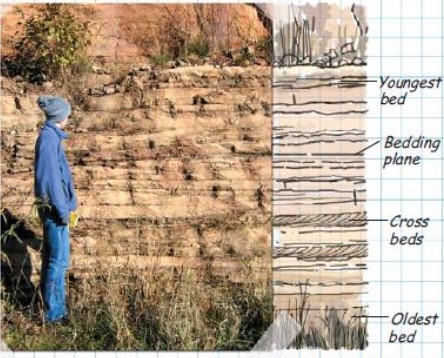
Law of Original horizontality:
strata were close to being horizontal when they were originally deposited because sediments accumulate on surfaces of low relief (such as floodplains or the sea floor) in a gravitational field. If sediments were deposited on a steep slope, they would likely slide downslope before they could be buried and lithified. With this principle in mind, geologists conclude that examples of folds and tilted beds represent the consequences of deformation after deposition. (fig d)
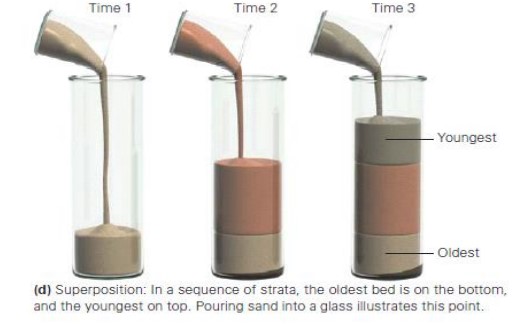
Law of original lateral continuity:
strata were originally laterally extensive relative to their thickness when they were deposited. (Fig e)
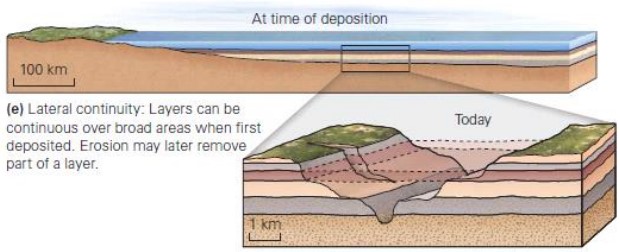
Principle of Crosscutting Relationship
It states that if one geologic feature cuts across another, the feature that has been cut is older. For example, if an igneous dike cuts across a sequence of sedimentary beds, the beds must be older than the Dike. If a fault cuts across and displaces layers of sedimentary rock, then the fault must be younger than the layers. But if a layer of sediment buries a fault, the sediment must be younger than the fault.

Principles of Inclusions
The principle of inclusions states that a rock containing an inclusion (fragment of another rock) must be younger than the inclusion. For example, a conglomerate containing pebbles of basalt is younger than the basalt, and a sill containing fragments of sandstone must be younger than the sandstone.
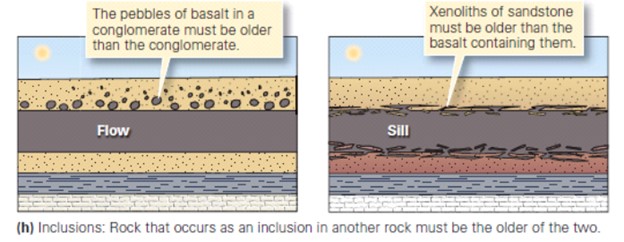
Principle of Faunal Succession
In the early 1800s, William Smith in England and Georges Cuvier in France used the successions of faunas in stratified rocks for mapping, This led to the development of the principle called the law of faunal succession: distinct faunas succeed one another regularly in the rocks.
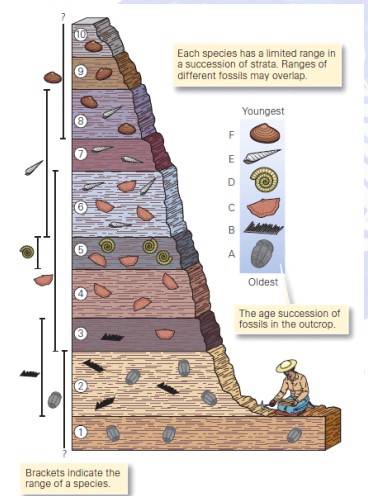
Principles of Baked Contacts
The principle of baked contacts states that an igneous intrusion “bakes” (metamorphoses) surrounding rocks, so the rock that has been baked must be older than the intrusion.

Conformability
Conformable strata are characterized by unbroken depositional assemblages, generally deposited in parallel order, in which layers are formed one above the other by more or less uninterrupted deposition. The surface that separates conformable strata is conformity, that is, a surface that separates younger strata from older rocks but along which there is no physical evidence of non-deposition. A conformable contact indicates that no significant break or hiatus in deposition has occurred. A hiatus is a break or interruption in the continuity of the geologic record. It represents periods of geologic time (short or long) for which there are no sediments or strata.
Contacts between conformable strata: Contacts between conformable strata may be either abrupt or gradational.
Abrupt contacts :
Abrupt contacts directly separate beds of distinctly different lithology.
minor depositional breaks, involving only short hiatuses in sedimentation with little or no erosion caused by floods, storms, etc before deposition is resumed, are called diastems. Post-depositional chemical alteration of beds, producing changes in color owing to oxidation or reduction of iron-bearing minerals, changes in grain size owing to recrystallization or dolomitization, changes in resistance to weathering owing to cementation by silica or carbonate minerals
Gradational contacts:
Conformable contacts are said to be gradational if the change from one lithology to another is less marked than abrupt contacts, reflecting gradual changes in depositional conditions with time. Gradational contacts may be of either the progressive gradual type or the intercalated type Progressive gradual contacts occur where one lithology grades into another by progressive, more or less uniform changes in grain size, mineral composition, or other physical characteristics.
Intercalated contacts are gradational contacts that occur because of an increasing number of thin inter-beds of another lithology that appear upward in the section.
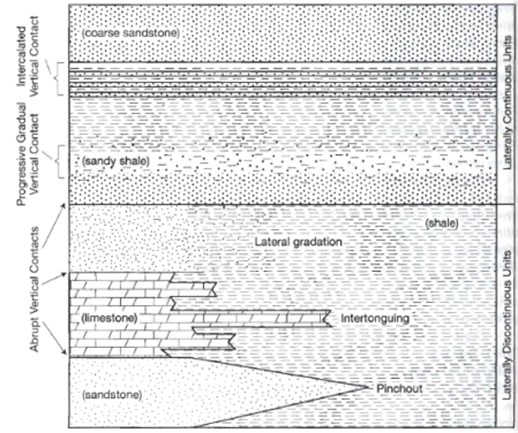
Principle of Unconformities
When we observe layers of rock that have been deposited essentially without interruption, we call them conformable.
Throughout Earth’s history, the deposition of sediment has been interrupted over and over again. All such breaks in the rock record are termed unconformities. An unconformity represents a long period during which deposition ceased, erosion removed previously formed rocks, and then deposition resumed.
Unconformities are important features because they represent significant geologic events in Earth’s history. There are four basic types of unconformities, and their recognition helps geologists identify what intervals of time are not represented by strata and thus are missing from the geologic record.
Walther Law of Facies
The principle that facies that occur in conformable vertical successions of strata also occur in laterally adjacent environments The various deposits of the same facies-area and similarly the sum of the rocks of different facies-areas are formed beside each other in space, though in a cross-section we see them lying on top of each other.
Sedimentary rock types record the environment of their deposition. Depositional environments can shift laterally as conditions change. (Regression and Transgression)
Important Questions??
What are the 4 Laws of Stratigraphy?
Steno’s laws of stratigraphy describe the patterns in which rock layers are deposited. The four laws are:
- Law of Superposition – In an undeformed sequence of rock layers, the oldest layer is at the bottom, and each successive layer above it is younger.
- Law of Original Horizontality – Layers of sediment are originally deposited in horizontal layers due to gravity.
- Law of Cross-Cutting Relationships – Any geological feature that cuts across another is younger than the feature it cuts through.
- Law of Lateral Continuity – Layers of sediment extend laterally in all directions until they thin out or encounter a barrier.
What are the Principles of Stratigraphy?
Stratigraphic studies are based on the following principles:
- Order of Superposition – Older layers lie beneath younger layers.
- Original Horizontality – Layers of sediment are initially deposited horizontally.
- Lateral Continuity – Sedimentary layers spread outwards until they taper off.
- Cross-Cutting Relationships – Intrusions or faults cutting across layers are younger than the layers they intersect.
- Inclusions – Fragments of one rock included in another must be older than the host rock.
- Unconformities – Gaps in the geological record due to erosion or non-deposition.
- Fossil Succession – Fossil organisms succeed one another in a definite, recognizable order.
- Uniformitarianism – The present is the key to the past; past geological processes operated the same way as they do today.
- Catastrophism – Earth’s history includes sudden, short-lived, violent events.
Who Described Three Founding Principles of Stratigraphy?
In 1669, Nicolaus Steno formulated three basic principles for understanding Earth’s geological history:
- Principle of Superposition – Older layers are beneath younger layers.
- Principle of Original Horizontality – Sediments are deposited in horizontal layers.
- Principle of Lateral Continuity – Sedimentary layers extend outward until they thin out.
What are the Key Concepts of Sequence Stratigraphy?
Sequence stratigraphy studies cyclic sedimentation patterns formed due to changes in accommodation space (available space for sediment deposition) and sediment supply. Key concepts include:
- Stratigraphic Cyclicity – Repetitive sedimentation patterns at different scales.
- Sequence Boundaries – Surfaces separating different depositional sequences.
- Parasequences – Small-scale sequences within larger sequences.
- Systems Tracts – Packages of sedimentary deposits formed during sea-level changes.
How Do We Use Principles of Stratigraphy to Define Earth’s Age?
Geologists determine Earth’s age by analyzing sedimentary rock layers:
- Relative Dating – Determines the sequence of rock formations using superposition, original horizontality, and fossil succession.
- Absolute Dating – Uses radiometric dating to assign numerical ages to rock layers.
- Correlation – Matching rock layers from different locations based on fossil evidence and lithology.
How Many Types of Superposition Principles Are There?
There are two types of superposition of waves:
- Constructive Interference – When two waves combine to create a larger amplitude.
- Destructive Interference – When two waves combine to reduce or cancel out amplitude.
What Are the Laws of Stratigraphy Oldest to Youngest?
The Law of Superposition states that older rock layers are at the bottom, while younger rock layers are deposited on top.
What is the Basic Principle of Superposition?
The Principle of Superposition states that in an undeformed sedimentary sequence, older layers lie beneath younger layers.
What is an Example of Steno’s Law?
An example of Steno’s Law is found in igneous intrusions:
- If an igneous intrusion cuts through metamorphic rock, the intrusion is younger than the surrounding metamorphic rock.
A real-world example is the Grand Canyon, where rock layers follow Steno’s principles.
What are the Four Types of Stratigraphy?
- Lithostratigraphy – Study of rock layers based on composition.
- Biostratigraphy – Uses fossils to determine relative ages.
- Chronostratigraphy – Focuses on time-based rock divisions.
- Magnetostratigraphy – Uses Earth’s magnetic field reversals in rock layers.
Who is the Father of Stratigraphy?
Nicolaus Steno is known as the Father of Stratigraphy for establishing fundamental principles of geological layering.
What is the Simple Definition of Stratigraphy?
Stratigraphy is the study of rock layers (strata) and their sequence, distribution, and age relationships to reconstruct Earth’s history.
What is the Difference Between Stratigraphy and Superposition?
- Stratigraphy studies rock layers and their history.
- Superposition is a principle stating that oldest layers lie beneath younger layers in a sedimentary sequence.
Is Stratigraphy Absolute or Relative?
Stratigraphy is primarily used for relative dating, determining the sequence of rock formations but not their exact age.
What is Steno’s Law?
Steno’s Law states that the angles between corresponding faces of crystals remain constant, characteristic of a given mineral species.
Who is the Godfather of Geology?
James Hutton, a Scottish naturalist, is called the Father of Geology for introducing the Theory of Uniformitarianism.
What is the Law of Uniformitarianism?
Uniformitarianism states that geological processes occurring today operated the same way in the past.
What is Relative Age Dating?
Relative dating determines the order of past geological events without assigning exact numerical ages.
How Many Stratigraphic Principles Are There?
There are six basic stratigraphic principles:
- Original Horizontality
- Superposition
- Lateral Continuity
- Cross-Cutting Relationships
- Inclusions
- Fossil Succession
What are the Three Types of Unconformities?
- Angular Unconformity – Tilted rock layers overlain by younger horizontal layers.
- Disconformity – Erosional surface separating two parallel layers.
- Nonconformity – Sedimentary rocks rest on eroded igneous or metamorphic rocks.
What is the Principle of Inclusions?
The Principle of Inclusions states that rock fragments found inside another rock must be older than the host rock.
What is Charles Lyell’s Theory?
Charles Lyell promoted Uniformitarianism, arguing that geological processes operate consistently over time.
What is the Uniformity Principle?
The Uniformity Principle (Uniformitarianism) asserts that past geological events can be understood by studying present-day processes.
What is Chronostratigraphy?
Chronostratigraphy deals with dating rock layers based on time rather than composition or fossil content.
What is the Oldest Unconformity?
The Great Unconformity in the Grand Canyon, formed 1.25–1.35 billion years ago, is one of the oldest known unconformities.
How Does Seriation Work?
Seriation orders artifacts or rock layers chronologically based on style changes over time.
